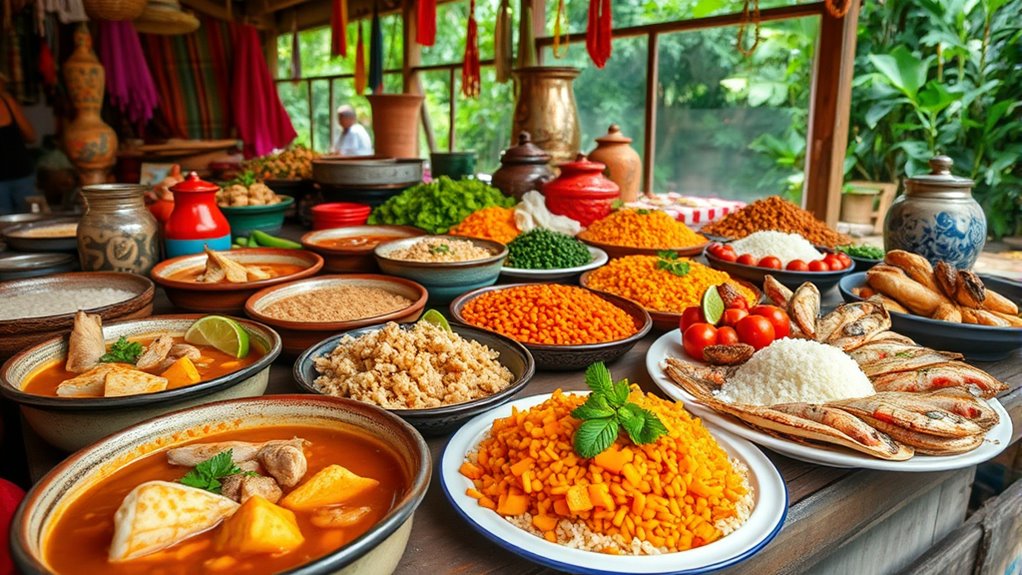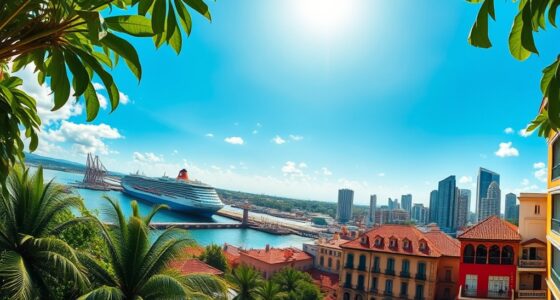Panama’s cuisine reflects a vibrant mix of indigenous, Spanish, African, and Caribbean influences. You’ll find hearty dishes like sancocho de gallina, seafood prepared with coconut, and street foods such as empanadas and carimañolas. Local ingredients like maize, yuca, tropical fruits, and fresh seafood are key. Traditional seasonings enhance flavors, and cooking methods include roasting, boiling, and frying. To understand how these elements come together, explore the rich culinary heritage shaping Panama’s festive and everyday foods.
Key Takeaways
- Panama’s cuisine blends indigenous, Spanish, African, and Caribbean influences, reflected in dishes like sancocho, tamales, and seafood preparations.
- Key ingredients include yuca, maize, plantains, tropical fruits, and fresh seafood seasoned with native herbs and spices.
- Traditional cooking methods feature roasting, boiling in banana leaves, deep frying, and grilling, especially during celebrations.
- Celebratory foods such as tamales panameños, fruitcake, and arroz con pollo symbolize cultural identity and social cohesion.
- Street foods like empanadas and carimañolas are popular snacks, emphasizing communal eating and vibrant culinary traditions.
Traditional Dishes and Regional Flavors
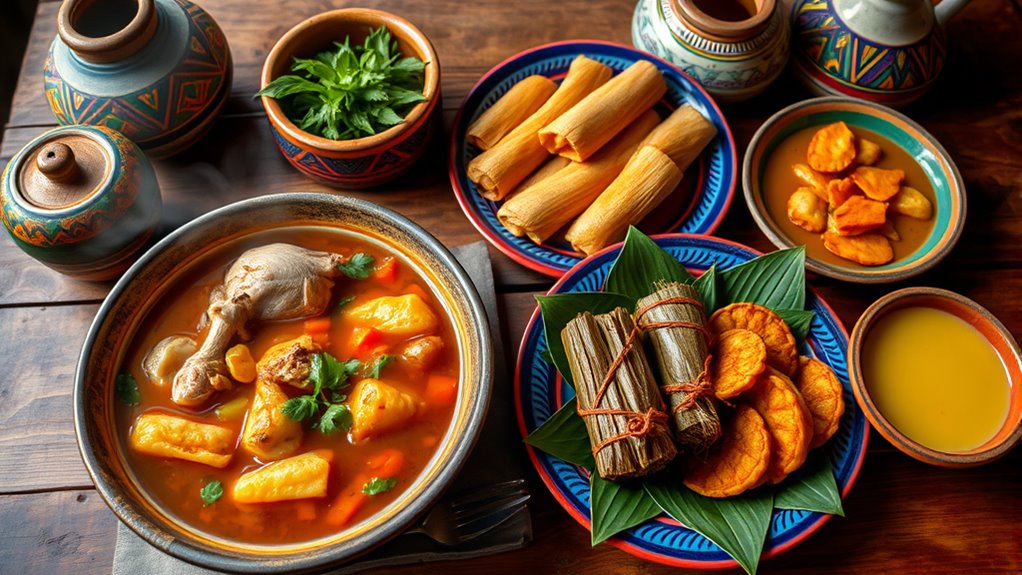
Panamanian traditional dishes showcase a vibrant blend of regional flavors shaped by indigenous, Spanish, and Afro-Caribbean influences. You’ll find hearty stews like sancocho de gallina, featuring chicken, corn, and root vegetables, representing indigenous roots. In coastal areas, seafood dishes such as grilled fish and coconut-infused preparations reflect Afro-Caribbean traditions. Street foods like empanadas and carimañolas, filled with seasoned meats and fried to perfection, highlight local snack culture. Tamales panameños, wrapped in banana leaves, showcase the importance of maize and traditional cooking methods. These dishes often combine native ingredients with Spanish spices and Afro-Caribbean flavors, creating a diverse culinary landscape. Whether enjoyed in rural villages or urban markets, each dish tells a story of Panama’s rich, multicultural heritage. Understanding traditional cooking methods can deepen appreciation for how these dishes are crafted and preserved over generations.
Key Ingredients and Unique Seasonings

The vibrant flavors of Panama’s cuisine hinge on its distinctive ingredients and seasonings, which reflect a fusion of indigenous, Spanish, and Afro-Caribbean influences. You’ll find culantro, a pungent herb similar to cilantro, essential in dishes like sancocho and tamales. Root vegetables like yuca, ñame, and otoe are staples, adding earthy textures to stews and fritters. Corn is central, used in tamales, bread, and empanadas, symbolizing cultural roots. Coastal regions emphasize fresh seafood, often seasoned with coconut, garlic, and peppers. Tropical fruits such as pineapple, mango, and plantains elevate both savory and sweet dishes, adding natural sweetness and acidity. These ingredients and seasonings create the bold, aromatic, and diverse flavors that define Panama’s culinary landscape. Additionally, incorporating seasoning techniques such as marination and slow cooking enhances the depth of flavors in many traditional dishes.
Cultural Influences and Culinary Heritage
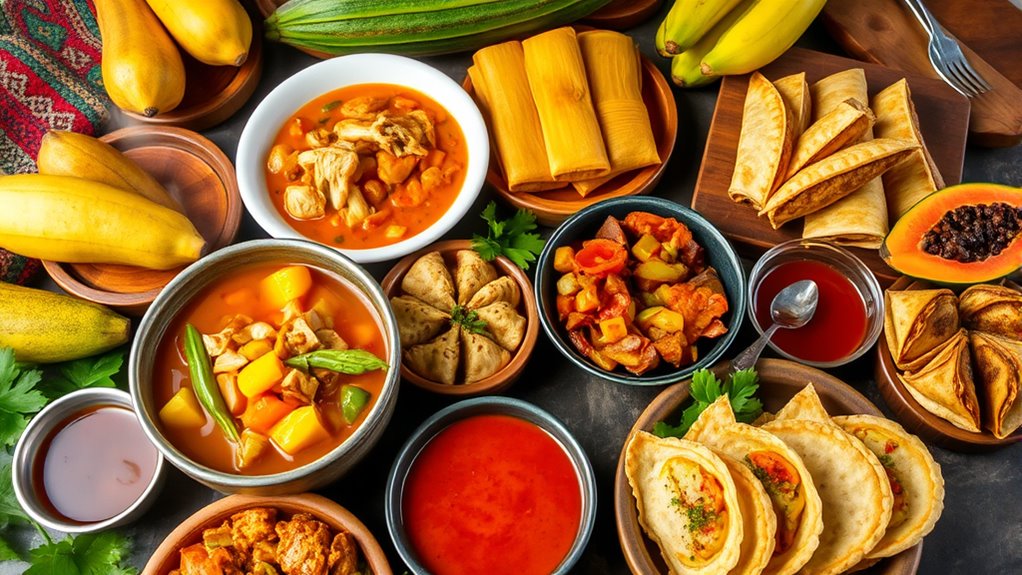
You can see how Panama’s culinary heritage reflects its diverse history, with indigenous ingredients like yuca and corn forming the foundation. Spanish colonization introduced rich meat stews and rice dishes, shaping the mainstay flavors. At the same time, Afro-Caribbean influences bring vibrant spices and fried snacks, creating a truly multicultural cuisine. Additionally, the blending of these culinary traditions often mirrors the symbolism found in prophetic dreams, where symbols and cultural elements merge to convey deeper meanings.
Indigenous Culinary Roots
Indigenous peoples have deeply shaped Panama’s culinary heritage, leaving a lasting mark through their use of native ingredients and traditional cooking methods. You’ll notice their influence in dishes like sancocho de gallina, which uses yuca, ñame, and culantro—staples of pre-Columbian cuisine. Root vegetables, such as otoe and plantains, are prevalent in many recipes, reflecting their importance in indigenous diets. You’ll also find techniques like boiling in banana leaves for tamales and bolo de maíz, highlighting ancient methods of cooking that preserve moisture and flavor. The indigenous focus on fresh, locally sourced ingredients fosters a vibrant, aromatic culinary tradition. Their legacy continues to inform Panamanian cuisine, blending seamlessly with other cultural influences to create a rich, diverse food culture grounded in indigenous roots. Additionally, the preservation of these traditional ingredients and techniques highlights the enduring significance of indigenous culinary practices in Panama today.
Spanish Colonial Legacy
Spanish colonization left a lasting imprint on Panama’s culinary landscape, introducing ingredients, cooking techniques, and dishes that have become integral to local cuisine. You’ll notice the influence in hearty meat stews, such as ropa vieja, and rice dishes like arroz con pollo, which blend Spanish recipes with local ingredients. Herbs like garlic, onions, and culantro were brought from Spain and now flavor many dishes. The use of broths and slow-cooking methods reflects traditional Spanish techniques, adding depth and aroma to stews. You’ll also find pastries like churros and sweet tamales that echo Spanish desserts. These culinary elements have merged with indigenous and Afro-Caribbean foods, creating a diverse and flavorful Panama cuisine rooted in its colonial history.
Afro-Caribbean Contributions
How have Afro-Caribbean communities shaped Panama’s culinary landscape? They’ve introduced rich flavors, unique ingredients, and vibrant cooking techniques that define coastal cuisine. Their influence is evident in dishes like fried snacks, coconut-infused stews, and spicy seasonings. You’ll notice a focus on bold tastes and aromatic herbs that reflect their Caribbean roots. Key contributions include:
- Use of coconut milk and shredded coconut in stews and desserts
- Popular fried snacks like carimañolas and empanadas
- Spicy seasoning blends with peppers and culantro
- Incorporation of seafood, especially shellfish and fish
- Traditional dishes like sancocho de gallina with Afro-Caribbean spices
These elements blend seamlessly with indigenous and Spanish influences, creating Panama’s diverse and flavorful culinary identity. Afro-Caribbean traditions continue to energize the country’s vibrant food scene today. Cultural influences have played a crucial role in shaping the unique flavors and techniques that characterize Panama’s coastal cuisine.
Typical Meal Components and Serving Customs
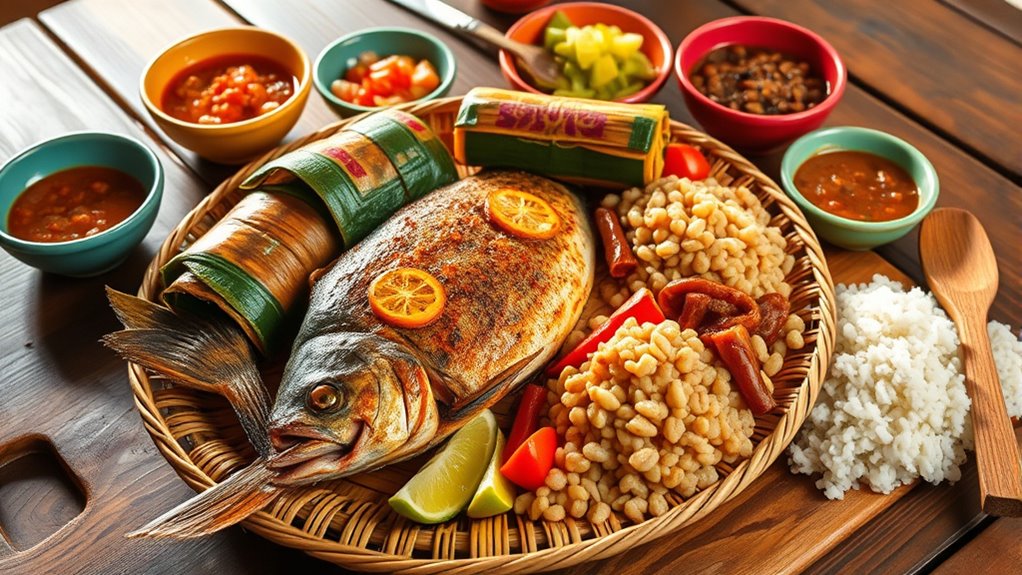
Panamanian meals typically revolve around hearty staples like rice and beans, which serve as the foundation for most dishes. You’ll find these paired with meats, seafood, or vegetables, creating balanced, filling meals. Sharing food is essential; families gather around large platters of sancocho or arroz con pollo, emphasizing community. Street foods like empanadas and carimañolas are quick, popular snacks. Meals are often served with broths or sauces that enhance flavors without overpowering. Low light office plants can be a great addition to kitchens or dining areas, adding greenery without requiring much sunlight.
Popular Sweets and Desserts of Panama
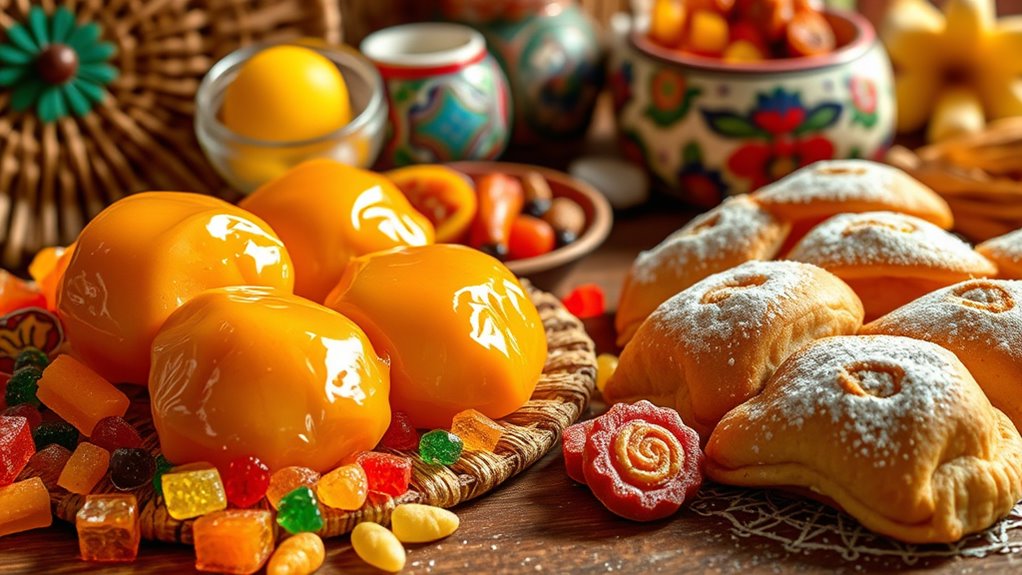
Sweet treats are an essential part of Panama’s culinary heritage, offering a delicious glimpse into the country’s diverse cultural influences. You’ll find a variety of desserts that showcase tropical fruits, spices, and local ingredients. Panamanian fruitcake is dense and moist, packed with dried fruits and spices like cinnamon and nutmeg, often soaked in rum during holidays. Churros are crispy fried dough sticks coated in sugar, sometimes dipped in chocolate—perfect for a quick snack or dessert. Bolo de Maíz Nuevo, made from fresh corn, is usually served with cheese and coffee, highlighting indigenous roots. Tropical fruit-based sweets, such as mango and pineapple jams, bring vibrant flavors to desserts. Occasionally, sweet tamales filled with raisins or fruits provide a delightful contrast to their savory counterparts. Additionally, traditional cultural influences are reflected in the variety of sweets enjoyed across different regions of Panama.
Cooking Techniques and Preparation Methods
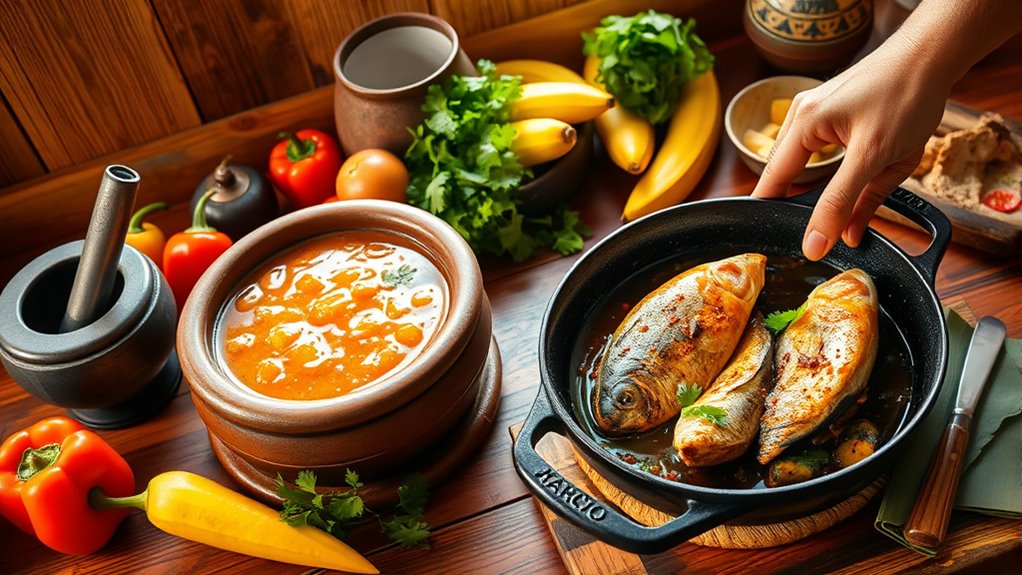
Cooking techniques in Panama emphasize enhancing natural flavors while preserving ingredient integrity. You’ll often slow-cook stews like sancocho and ropa vieja to develop rich, layered tastes and tenderize meats. Deep frying is popular for snacks such as carimañolas and empanadas, giving them crispy exteriors and flavorful fillings. Boiling foods in banana leaves or corn husks, as seen in tamales and bolo de maíz, infuses dishes with aroma and moisture. Coastal seafood is typically grilled or baked to preserve freshness and natural flavors. You use local herbs like culantro, garlic, and onions to add aromatic depth. These methods highlight the country’s diverse ingredients and cultural influences, creating vibrant, hearty dishes that honor Panama’s culinary heritage. Additionally, understanding Gold IRA options can be an important aspect of financial planning for many individuals.
Celebratory Foods and Special Occasion Dishes
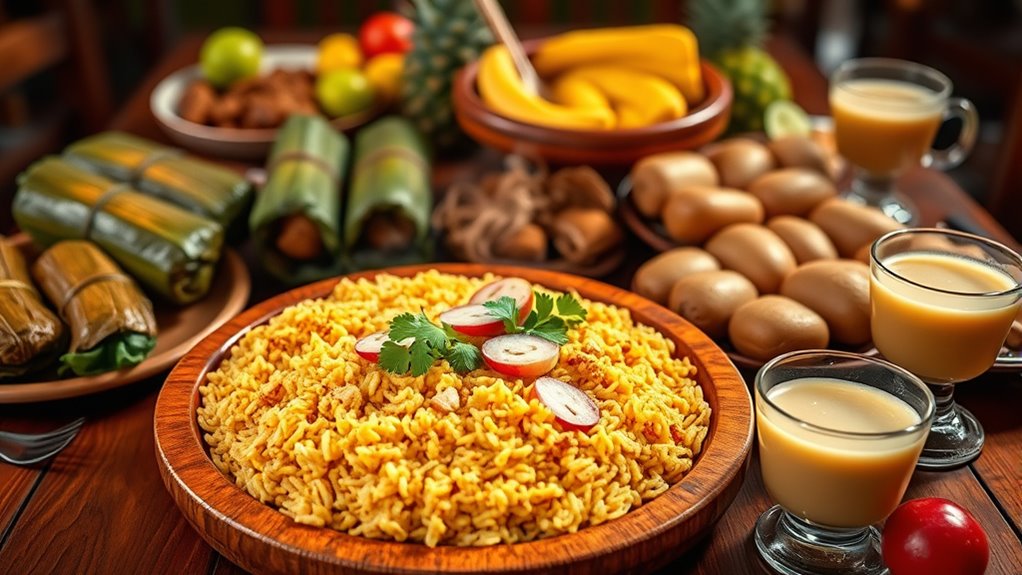
Celebratory foods in Panama play an essential role in bringing families and communities together during special occasions. When you celebrate, you’ll find dishes that highlight tradition and regional flavors. These include:
Celebratory foods in Panama unite families and communities through traditional regional flavors.
- Tamales Panameños: Corn dough stuffed with pork or chicken, wrapped in banana leaves, and enjoyed during Christmas and holidays.
- Panamanian Fruitcake: Dense, moist cake with dried fruits, spices, and sometimes soaked in rum, served at weddings and festivals.
- Sweet Tamales: Variants with raisins or sweet fillings, often prepared for New Year’s celebrations.
- Arroz con Pollo: A festive chicken and rice dish seasoned with Latin spices, perfect for family gatherings.
- Empanadas: Fried or baked pastries filled with meat or sweet ingredients, common at festivals and community events.
- Additionally, traditional cooking methods like slow roasting and the use of fresh, local ingredients help preserve the authenticity of these dishes.
Frequently Asked Questions
What Are Some Lesser-Known Traditional Panamanian Dishes?
You should try lesser-known Panamanian dishes like Arroz con Pato, a flavorful duck and rice stew seasoned with herbs and spices, or Bollo de Maíz Nuevo, a fresh corn bread cooked in husks often served with cheese. Also, explore Carimañolas filled with cheese or seasoned seafood, and Sancocho de Pescado, a hearty fish stew with root vegetables. These dishes showcase regional ingredients and unique cooking techniques worth discovering.
How Do Regional Differences Influence Panamanian Cuisine?
You’ll notice that regional differences shape Panamanian cuisine markedly. Coastal areas emphasize seafood dishes like grilled fish and coconut-flavored recipes, reflecting their access to the sea. In contrast, interior regions favor hearty stews like sancocho de gallina with root vegetables, showcasing indigenous ingredients. Urban centers blend influences from Spanish, Afro-Caribbean, and immigrant communities, creating diverse flavors and techniques that make each region’s cuisine unique.
Are There Specific Dietary Restrictions Common in Panama?
You’ll find that dietary restrictions in Panama are often linked to religious beliefs, health concerns, or cultural practices. Many Panamanians avoid pork for religious reasons, especially among Jewish and Muslim communities. Others limit salt or spicy foods due to health issues like hypertension or ulcers. Vegetarianism is growing, but meat, especially chicken and beef, remains central. Overall, you’ll notice a balance of traditional and modern dietary preferences shaping Panamanian eating habits.
What Are Popular Street Foods Beyond Empanadas and Carimañolas?
Ever imagine walking through Panama’s lively streets? Beyond empanadas and carimañolas, you’ll find delicious options like fried plantains, sweet tamarind candies, and crispy fried fish snacks. Have you tasted the colorful chorizo-style sausages or the freshly grilled seafood skewers? These street foods burst with local flavors, offering quick bites that satisfy your hunger while immersing you in Panama’s vibrant culinary culture.
How Has Modern Cuisine Impacted Traditional Panamanian Recipes?
Modern cuisine has blended new ingredients and techniques into traditional Panamanian recipes, making them more innovative and globally appealing. You might find fusion dishes that combine local staples with international flavors, like sushi with tropical fruits or quinoa salads with native herbs. This evolution keeps the cuisine vibrant and relevant, encouraging you to explore familiar dishes in fresh ways while respecting their cultural roots.
Conclusion
As you explore Panama’s rich culinary tapestry, remember that its flavors tell a story as vibrant as a carnival parade. From hearty dishes to sweet treats, each bite reflects centuries of cultural fusion. Embrace these traditions and let your taste buds dance like a lively drumbeat. Just as Panama’s landscapes blend diverse influences, so too does its cuisine invite you to savor a world of unforgettable flavors and stories waiting to be discovered.

